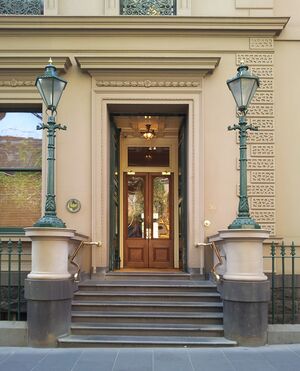Melbourne Club
(Private club, Deep state milieu) | |
|---|---|
 | |
| Formation | 1838 |
| Headquarters | |
| Membership | • Sir Isaac Isaacs • • Ninian Stephen • Peter Hollingworth • Henry Winneke • James Gobbo • Alex Cherno • John Latham • Owen Dixon • Daryl Dawson • Kenneth Madison Hayne • William Foster Stawel • William Irvine • Frederick Mann • Edmund Herring • Henry Winnek • John McIntosh Young • Viscount Bruce of Melbourne • • John Bloomfield • Andrew Peacock • Brudenell White • William Johnston • William Bridges • William Mitchell • Charles MacMaho • Frederick Standish • Robert O'Hara Burk • Arthur Streeton • Daryl Lindsay • William Dargie • James Balderstone |
| Australian deep state milieu | |
The Melbourne Club is a private social club established in 1838 and located at 36 Collins Street, Melbourne. The present and historical membership lists and number of members are kept a secret[1], but is believed to be around 1500[2].
It has connections to similar clubs around country Victoria, and the membership, linked to "old money", is of heavily Anglo-Celtic stock.[2]
The membership is male only, and one needs to be sponsored by several of the other members (5 or 6), to sign and recommend you. Then, when a slot opens up if they are at full capacity, and at the usually annual meeting for this purpose they will vote on members being put up for membership. If one member says no, the answer is no. It’s about $30k to join if one is young. The annual fee, is around $2000[1], but in some cases could be as high as $50k.
As late as 1994, the Liberal Party anointed its new leader in a private room at the Melbourne Club, where party president Tony Staley told Alexander Downer the job could be his.[1]
The Premises
The club is a symbol of Australia's British social heritage and was established at a gathering of 23 gentlemen on Saturday, 17 December 1838, and initially used John Pascoe Fawkner's hotel on the corner of Collins Street and Market Street.[3]
The Melbourne Club moved to new purpose-built premises at the eastern end of Collins Street, designed by Leonard Terry in Renaissance Revival style, in 1859.[4] A dining room wing with a bay window was added at the western end in 1885, designed by Terry and Oakden. It includes, among other rooms, a library, main dining room, private dining room, breakfast room, billiard rooms, lawn room and bedrooms. The building is listed on the Victorian Heritage Register.[4]
At the rear of the Club building is a private courtyard garden, maintained by arborist-horticulturalist John Fordham, which is also listed on the Victorian Heritage Register,[5] and is the location of garden parties and private functions. The garden contains the largest plane tree in Victoria, according to the National Trust's Register of Significant Trees.[5]
The Melbourne Club does not allow female membership.[6] The female-only Lyceum Club, located directly behind in Ridgway Place, enjoys views of the trees of the Melbourne Club's gardens.
Notable members
Frederick Powlett (1811–1865) was a founding member in 1838 as well as being a founding member and the first recorded president of the Melbourne Cricket Club in 1838. He was a public servant, a police magistrate and later chief commissioner of Crown Lands.
Other notable members:
- Governors-General Sir Isaac Isaacs GCB GCMG PC, KC, Baron Casey KG GCMG CH DSO MC PC, Sir Ninian Stephen KG AK GCMG GCVO KBE PC QC and Rt Rev Hon Peter Hollingworth AC OBE;
- Governors of Victoria Sir Henry Winneke AC KCMG KCVO OBE QC, Sir James Gobbo AC CVO QC and Hon Alex Chernov AC QC;
- Chief Justices of Australia Sir John Latham GCMG PC KC and Sir Owen Dixon OM GCMG PC KC ;
- High Court Justices Sir Daryl Dawson AC KBE CB QC Kenneth Madison Hayne AC QC;
- Chief Justices of Victoria Sir William Foster Stawell KCMG, Sir William Irvine GCMG, Sir Frederick Mann KCMG, Sir Edmund Herring KCMG KBE DSO MC KC, Sir Henry Winneke and Sir John McIntosh Young AC KCMG QC;
- Prime Ministers 1st Viscount Bruce of Melbourne CH MC FRS and Malcolm Fraser AC CH PC;
- Politicians Sir John Bloomfield QC, Andrew Peacock AC;
- Soldiers General Sir Brudenell White KCB KCMG KCVO DSO ADC, General Sir William Johnston and Major General Sir William Bridges KCB CMG;
- Chief Commissioners of Victoria Police Sir William Mitchell, Sir Charles MacMahon and Frederick Standish;[7]
- Explorer Robert O'Hara Burke;
- Artists Sir Arthur Streeton, Sir Daryl Lindsay and Sir William Dargie CBE ;
- Prominent businessmen Sir James Balderstone AC, Hugh Morgan AC, Don Argus AC and Kevan Gosper AO.[8]
Known members
3 of the 32 of the members already have pages here:
| Member | Description |
|---|---|
| Richard Casey | Australian who founded ASIS |
| Malcolm Fraser | Prime Minister of Australia from the 1975 coup until 1983. |
| William Mitchell | US Attorney General 1929-1933 |
References
- ↑ Jump up to: a b c https://www.crikey.com.au/2012/04/12/paul-barry-inside-melbournes-most-exclusive-club/
- ↑ Jump up to: a b https://www.smh.com.au/lifestyle/into-the-secretive-world-of-men-only-20090116-gdta07.html
- ↑ McNicoll, Ronald (1988). Number 36 Collins Street (2008 ed.). Australia: Allen & Unwin/Haynes in conjunction with the Melbourne Club.
- ↑ Jump up to: a b https://vhd.heritagecouncil.vic.gov.au/places/715
- ↑ Jump up to: a b http://www.theaustralian.com.au/life/home-design/gardening/open-gardens-melbourne-clubs-walled-oasis/news-story/94db0deacddb931163fe73f97a78631c
- ↑ http://www.abc.net.au/pm/content/2009/s2753500.htm
- ↑ https://trove.nla.gov.au/version/13647314
- ↑ http://www.abc.net.au/am/stories/s99461.htm